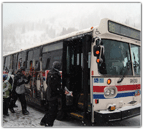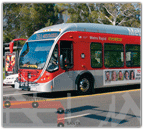U.S. slow to board the contactless train
24 January, 2013
category: Contactless, Transit
Transportation for London (TfL) announced the rollout of contactless credit card readers on all of the city’s 8,500 buses last month, enabling riders to charge their bus fare directly to their bank accounts.
According to The Atlantic, this will be an interesting test case for the future of contactless payments in public transportation systems, particularly in the United States. Will public transit riders really use contactless credit cards enough to meaningfully change the way that people pay for their transportation?
In the U.S., card companies and banks have introduced test markets for contactless cards in a few areas, like New York City, Atlanta, and Denver, and card companies report that millions of cards with contactless capabilities have been issued. However, of the more than 5 million businesses in the U.S., only 30,000 have the equipment required to accept contactless payments.
The use of contactless payments could also be cut short in the U.S. by the rapidly developing mobile payments market. In countries outside of the U.S. – take Kenya for example, where 80 percent of people are using mobile payment services – this has certainly been the case.
In the fall of 2011, the New Jersey Transit became one of the first transit authorities in the U.S. to accept the NFC-based Google Wallet and other forms of contactless payment at certain bus stations, which expanded to the Port Authority in 2012.
Regardless of the path that U.S. mass transit systems take, these advanced payment systems would increase the efficiency of current fare systems. Costs associated with operations – producing and maintaining card machines, transporting and counting hundreds of thousands of coins every day – would be virtually eliminated.



